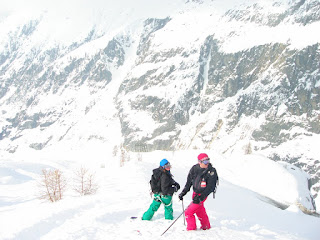
There is a very precise moment during the construction process when you begin to see the bag come to life. It is not a pre-defined moment, and the style of the bag will dictate when it will occur. Every part of the process leading up to that point is anxiously executed, awaiting this turning point. This is the turning point of the second handbag style I completed. Pictured above is the "interno," interior. As you can see, I learned how to complete an interior pocket, featuring the zipper that you saw previously.

The form on the left is the "interno" with the "fianco," side, attached. The flap on the right side of this part is called the "contrapatina," which is the under side of the internal part of the bag and is covered in leather or suede. The form on the right is the "esterno," exterior, which if all goes well, should mold perfectly around the "esterno" when complete. The small "bandaid-like" patches you see are pieces of "salpa" that enclose and reinforce the magnetic closure. The black salpa is pierced with a screwdriver to allow the parts of the magnetic clasp pass through, almost like a staple. These are covered in "salpa" so you won't see the metal from the exterior of the bag, while allowing the clasp to stay in place over time.

This is one of the most crucial moments in handbag construction: The point where the "interno" and "esterno" come together. There is a very precise method of walking these two pieces together that can sometimes (like in my case, last week) involve blood, sweat, and tears. You must first apply "mastice," glue, to the entire perimeter of both parts. Then, you have to start with the center point of the "fianco", pinching the edges together while you make your way around the perimter of the bag. It is like a waltz, with a specific series of steps that your hands must follow. You must move your hands in a fluid motion to mold the parts together. It is not as simple as just gluing them flat, you must glue following the form that the bag will finally take. If there is a part that puckers or falls short at an "angolo," corner, you must un-glue, re-glue, and start all over again. Of course if you do this three, four, or eight times, the leather begins to get weak and will break. Speaking from experience, there is a fixed time when each leather will just not give anymore. This differs with suede (averaging two attempts), fine garment leather, like lambskin (three, maximum) and coarse leather, which is much more forgiving. Of course you might be thinking that all of my handbags will from now on be coarse leather, but coarse leather has it's own limitations. There are other parts of the process such as sewing on the machine that are more forgiving on the suedes and lambskins, which means you must really know the skins and the tolerance each one will have for each part of the process.

Equally as crucial as the assembly described above is "turning" the bag. We call this "girare" in Italian, which literally translates to "to turn, to spin". Once you have assembled the esterno and interno, it is time to sew them together ("spin them" on the machine). In most cases this is one continuous seam around the perimeter of the bag, and you can imagine the pressure of getting this seam right. Once the needle punctures the leather, there is no turning back. If you mess it up, there is a very good chance your mistakes will be prominently displayed on your final product. The most difficult for me (prominently displayed on two out of three of my bags) was arriving at the corners, of the "fianco," side. Again, there is a specific movement that your body and hands must make to allow the machine to flow over these points. Don't forget, the needle is passing through two pieces of leather and two pieces of "salpa," both of which have been "rimbocato," edges having been wrapped, with "mastice," glue, totaling at least six layers of material.
I noticed something last week, after "Acci" nearly ate one of my bags. I should mention that as much as I would like to, I cannot always blame it on "Acci," our machine. Nine times out of ten it is me, my mental state, and how well I have constructed the bag that will determine how it will pass through. It also highly depends on the shoes I am wearing. If you remember back in the beginning I said I have to "pump" the pedal instead of putting my foot down and sewing straight through a seam. This is especially true when it comes to rounding corners and finishing 90 degree angle edges. If I am wearing shoes that do not allow me to feel the pedal easily, the sewing becomes much more difficult and I am not able to start and stop as fluidly. Therefore, on sewing days I must remember to wear shoes with flexible soles so I can pump the machine delicately.
I eat an apple every single day. I buy them from the same woman in the market, who knows exactly what I want and exactly the quantity I want on any given day. She knows my schedule, she knows when I will be out of town for the weekend, she knows just about everything. I have introduced my mom, my teacher, and those of my classmates who are now equally as obsessed with her fuji apples as I am. My classmates have found that it is absolutely necessary for me to eat my apple before I begin sewing. When I run into a snag, the first question always is, "hai mangiato la mela oggi," "have you eaten your apple today?"










































